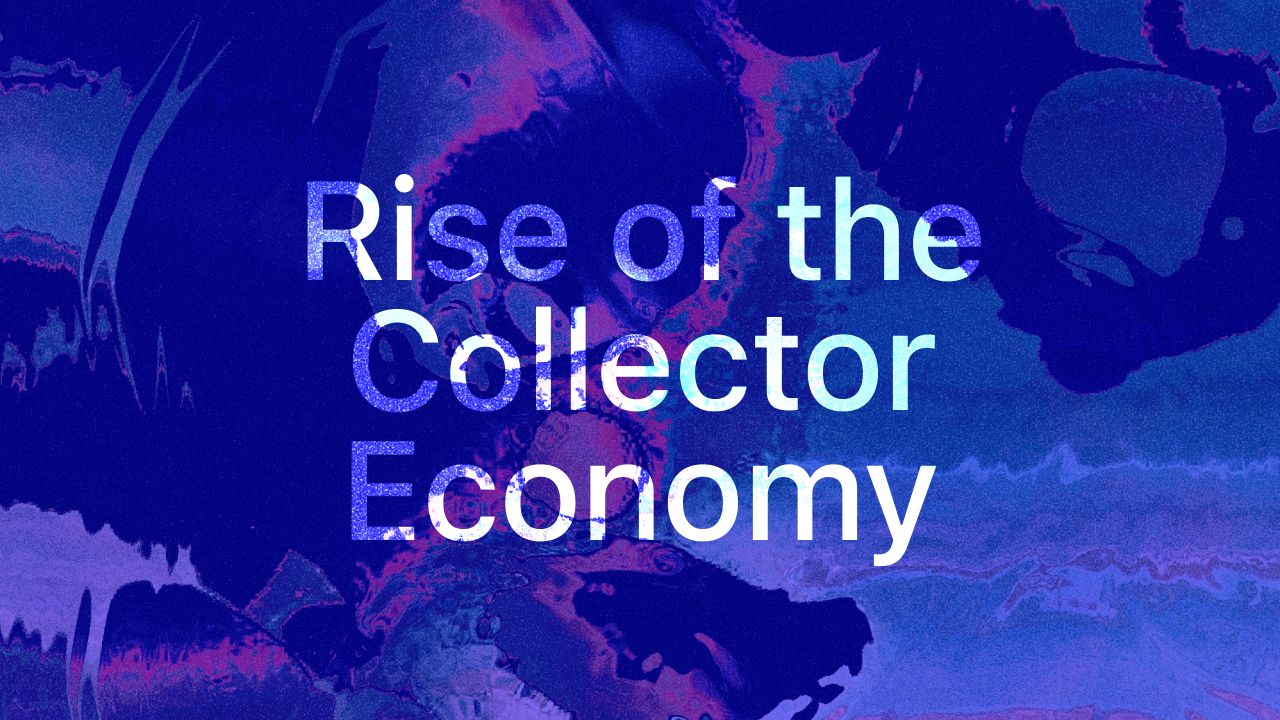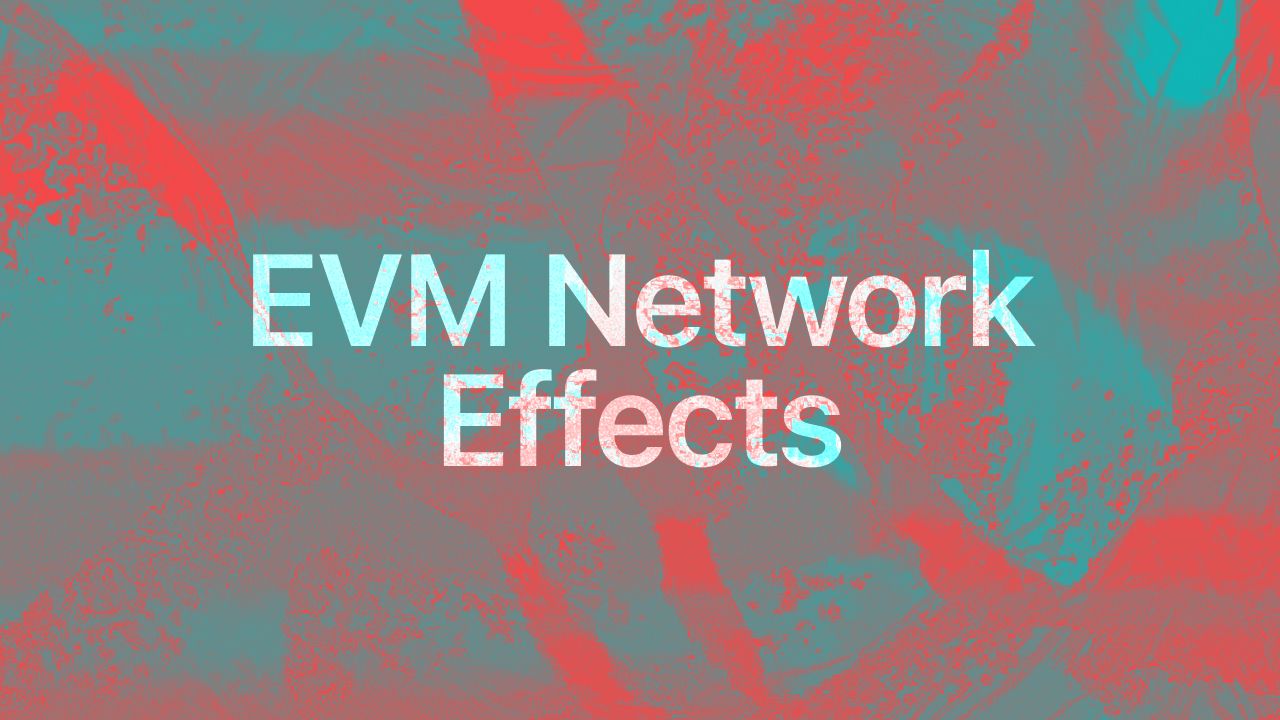The Social Experience of NFT Art (Part I)
NFT communities crave deeper online social experiences. Here is how cryptosocials can help.
By Mick Morucci - Mar 31, 2021
The beauty of art is that it derives its value entirely from the emotions it evokes and the social meanings ascribed to it. So art is deeply embedded in the relationships between artists, collectors, and the art community. Still, NFT platforms like OpenSea today are more like Amazon than, say, Instagram.. They mostly behave like transactional marketplaces that manage the minting, sale, and purchase of the art.
As a result, NFT art collectors and their communities are flocking to different social platforms such as Twitter, Telegram, Discord and Clubhouse in search of the social experiences they are craving. It is in these, not in NFT platforms, that artists are showcasing their new work, art curators and lovers are reacting and engaging with it, and the connection between artists, collectors, and fans is formed.
Shill me your personality, not your NFT art. Let’s connect before we buy or sell something. Community, right?!
— justinaversano (@justinaversano) March 14, 2021
NFTs go beyond speculation
Few know, for example, that while Beeple's private collection was first being auctioned for nearly $3.5 million (something that may feel merely speculative and transactional to outsiders), the artist was on WhatsApp privately messaging with the bidders, one of whom he had met the previous week in a chat room.
When artists create something new, they are building on top of everything that came before them. They're adding a new link to the chain of art, if you will. The same is true of collectors and influencers --- who want to show they're engaged in the conversation, whether they are bidding and want to be seen in the bid history, or they are purchasing the art.
Owning the art enables collectors to showcase that they belong to a community, support their favourite artists and the community they stand for, and flex their ability to purchase such high-priced art (hint hint Metakovan). These social dynamics determine how artists and collectors are perceived and whether the so-called piece of art should be considered art (and how much to value it at).
"The Creator Middle Class" has just been sold to @jamesyoung for 13.37 ETH. OMG. What a journey❣️
— Li Jin (@ljin18) March 13, 2021
Thank you to everyone who bid on this piece! It means the world to me that people support what it represents: a path for many, many creators to make a living and do what they love pic.twitter.com/JnTN2aTC2L
Note that the highest bid is 13.37, a magical internet number
THE MISSING (SOCIAL) LINK
While pioneers like Devin Finzer of OpenSea and Roham of CryptoKitties (now Dapper Labs) brought NFTs to the internet, we haven't yet fully recognized the social potential of digital art. Sure, some platforms are beginning to incorporate certain 'social' features such as artist bio, likes, follow button, and number of views. But very little is done to support the cravings of collectors for deeper social dynamics and bonds. For example, why do so few platforms enable us to comment on and react to the art directly, showcase and flex our collections, swap and trade NFTs, and view ongoing auctions in a live feed? Yes, there is a missing social link.
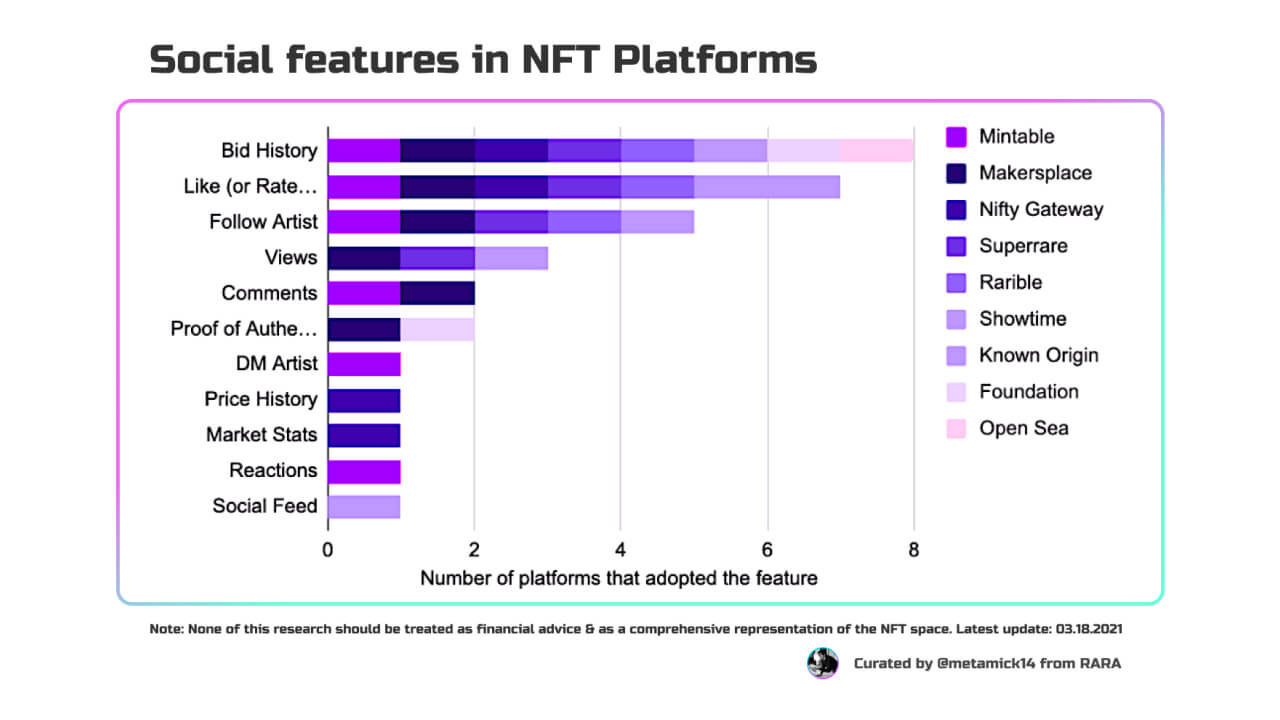
Communities have been growing rapidly
These lacking social engagement tools on NFT platforms led to the exorbitant growth of artistic community events on social platforms such as Discord, Telegram, Twitter, Clubhouse. Each NFT community is creating and curating the social experiences they crave - such as live auctions, collectible-fashion shows, Olympics in cyberspace within Crypovoxels, intellectual chronicles of the NFT space, NFT appreciation groups, and much more. All this is a testament to NFT communities' desire for that extra social experience beyond buying and selling of art.
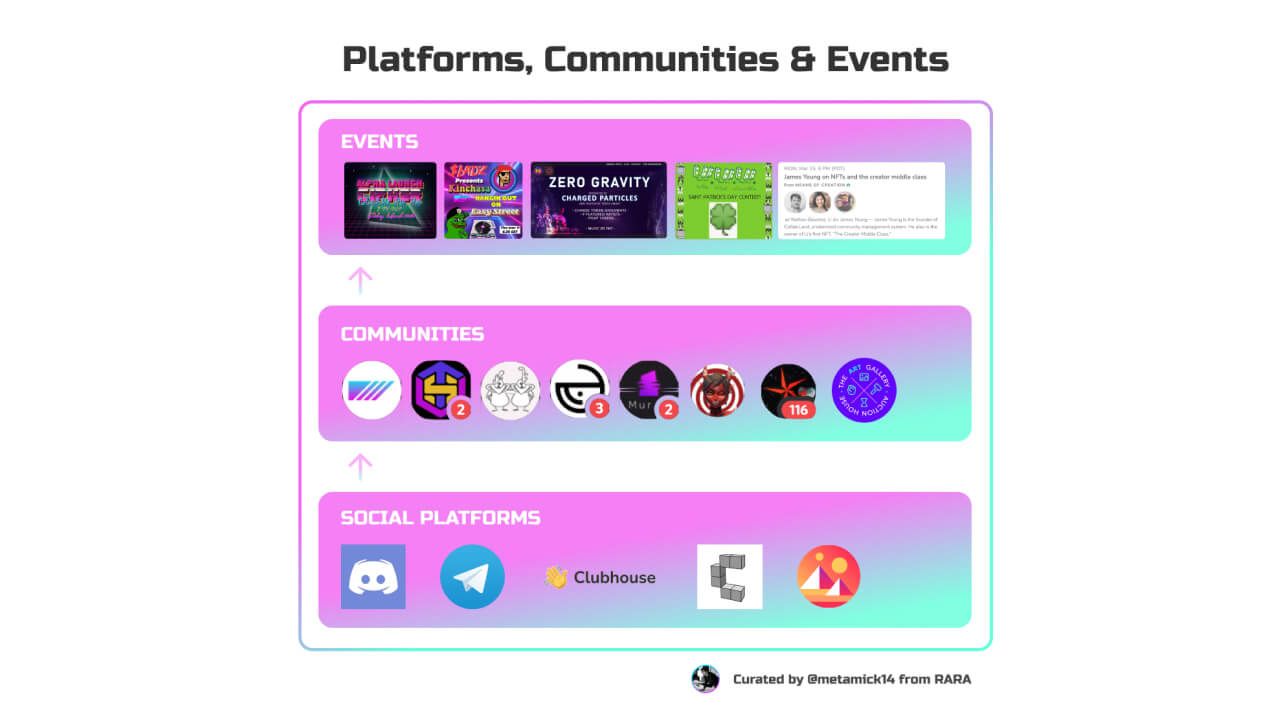
Live community events featuring NFT assets
The problem is that these events are all detached from the NFT assets themselves. So although communities gather to celebrate artists, interpret art, and craft collective beliefs around them, they must leave those social platforms if they want to interact with the actual NFT assets. So what's the solution?
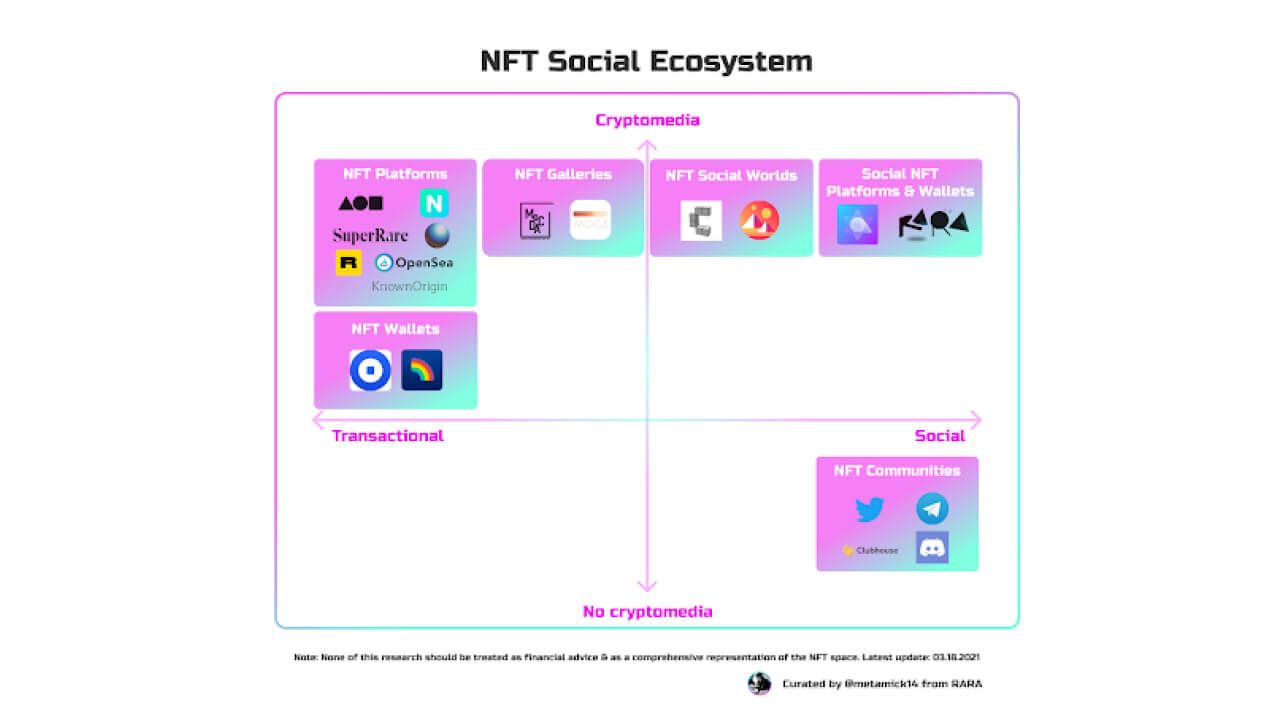
The missing link between Marketplaces and online communities
CRYPTOSOCIALs
Cryptosocials may very well be the solution. These are social networks that include cryptomedia, such as NFTs, and all the incentive tools we see today in crypto and De-Fi. So, what could cryptosocials look like?
One way cryptosocials might manifest is by bringing together the social platforms as we know them today with NFT assets -- such as by enabling NFT assets in their feeds. Or the other way around: NFT Wallets like Rainbow could introduce social media feeds and other social features. Unsurprisingly, platforms like Showtime are bringing Web 2.0 social features such as likes, comments, and follows to NFT assets. They are letting the NFT platforms do the minting and sale of NFTs so that they can focus on the social experience.
However, are likes, comments and follows going to be enough for NFT communities? Could we add incentives to this 'interaction layer' (see the graph below) of the social experience? Fractionalized NFTs and cryptoconsumables could do just that, by making certain types of interactions scarce, valuable, and, therefore, more engaging. Incentives can help artists to monetize their content while giving fans the opportunity to engage in deeper online experiences. Fan, investor, or user, the lines will become blurred.
And what about social feeds, are they going to be enough? Probably not, because NFT communities are already stretching beyond traditional social media environments and are quite literally meeting and engaging in live and interactive virtual worlds. These VR and virtual spaces not only provide more immersive social experiences than social feeds, but also bring digital assets to the 'environment layer' (see the graph below). Virtual crypto worlds such as Cryptovoxels are already doing that with digital land that is purchasable with ETH, and fashion collectibles that one can buy and wear as an avatar.
As the graph below shows, cryptosocials may radically change the nature of content, interactions, and environments that make up social platforms today. In fact, cryptosocials will augment and enhance our social experiences online by adding monetary value and incentives to them. This is where the distinction between socials (Web 2.0) and Cryptosocials (Web 3.0) really breaks down.
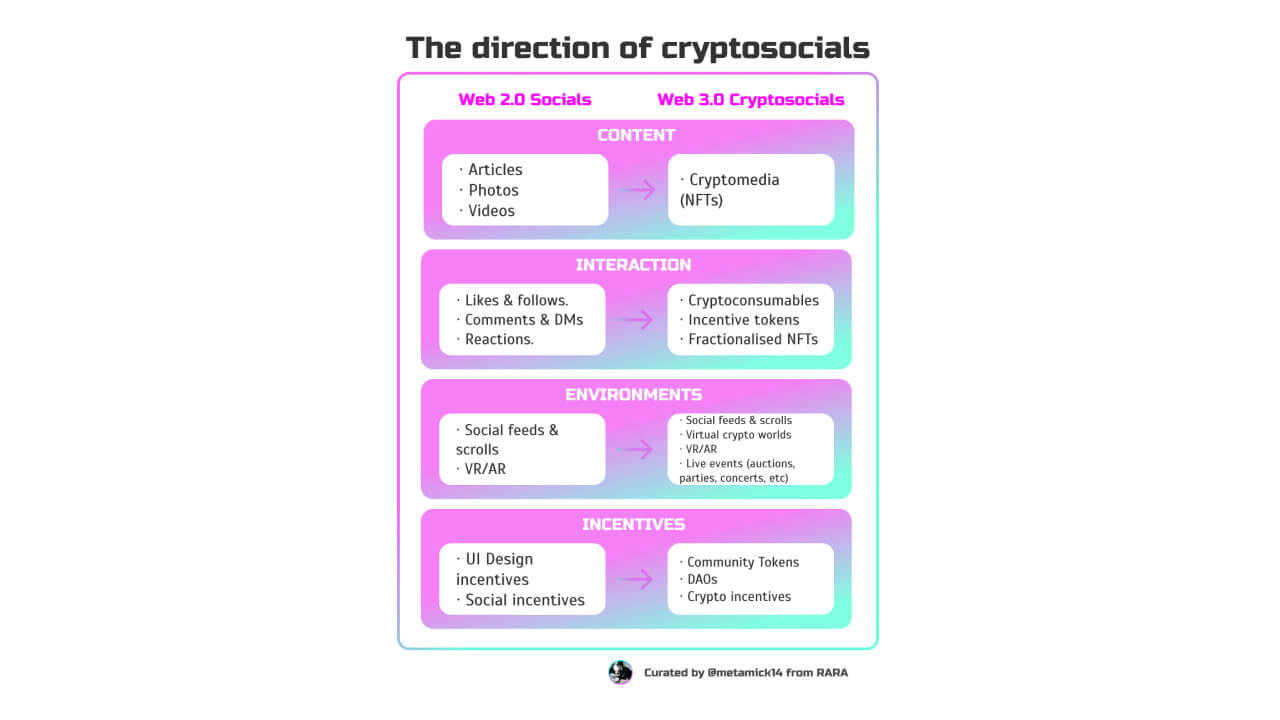
The layers of traditional vs cryptosocials. More on this will be described in the Part II of this series
Part II, The Role of Social Incentives for NFT art
In the next part of the series (Part II), Lawson Baker (founder of RARA) will dive deeper into the role of incentives in cryptosocials. We'll explore social money, cryptoconsumables, community tokens, and other social mechanisms.
About Mick
I'm an anthropologist and economist gone native in crypto. I work as product builder and user researcher at RARA.social, where we're on a mission to enable life, work and play on the Internet. To learn more about me or RARA, check out the links below:
- My twitter: @metamick14
- My website: mickmorucci.com
- RARA's website: rara.social
- RARA's Twitter: @rara_social
Acknowledgments
Thanks to the following people for their invaluable feedback on this article: Lawson Baker (founder of RARA) and Marguerite (aka Coin Artist), Chris Collins (Head of Biz Ops Foundation), Joey DeBruin (Forefront), and Paula Magal (Tech writer).
Other material
A beginners guide to NFTs by Linda Xie
Social Tokens Year In Review by Forefront.news
NFT issuance landscape.
NFTs could disrupt social media as we experience it today.
